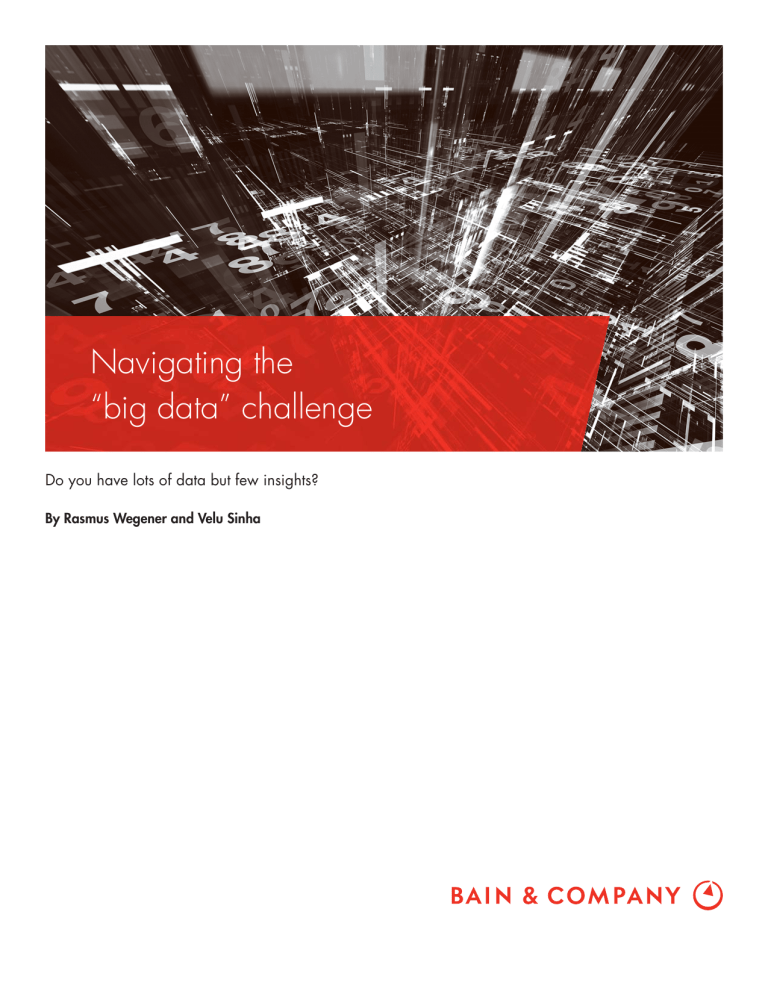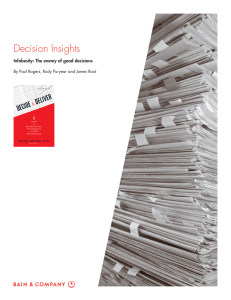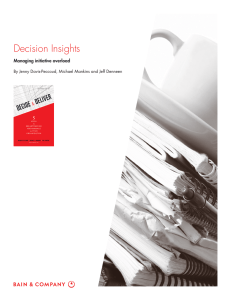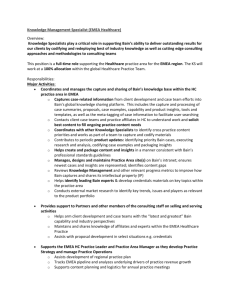Navigating the “big data” challenge By Rasmus Wegener and Velu Sinha
advertisement

Navigating the “big data” challenge Do you have lots of data but few insights? By Rasmus Wegener and Velu Sinha Rasmus Wegener is a partner with Bain & Company in Atlanta. Velu Sinha is a partner in Bain’s Palo Alto office. Both are members of Bain’s Technology practice. Copyright © 2012 Bain & Company, Inc. All rights reserved. Navigating the “big data” challenge Twenty years ago, business leaders wanted more data to data (see inform their decisions. Today they have so much data least three of these four issues, it’s unlikely they’re available—through indiscriminate collection and easy confronting a real big data problem, which means access to millions of data sets—that decision making their organization’s existing capabilities and tools has actually become more difficult. Significant insights may be sufficient for now. don’t spring from raw data. Someone has to know which Figure 1). If executives are not facing at Are you facing a big data problem? questions to ask of the data and where to find the answers. Volume Many companies face this problem, as they look to these vast stores of data to learn more about their markets, Does the problem require that large volumes (currently, their customers and their opportunities. In addition to from tens of terabytes up through petabytes) be ana- being creative, curious and business savvy, effective lyzed simultaneously? Some applications demand it. decision makers are learning to become more comfort- Consider Amazon’s recommendation engine, which able working with data and more capable of drawing aggregates and analyzes hundreds of terabytes of shop- insights from analysis. ping cart and click-through data from millions of users to determine which products are related. Combining For executives who have long wished for better answers, this information with a user’s online behavior generates “big data” can look like an easy win. They might be real-time product recommendations personalized to tempted to think that an expensive big data solution, each Amazon customer. on its own, can sort through data and deliver the new insights they are looking for. However, online retailers can often deliver fairly accurate recommendations by analyzing just a statistically As with any technological innovation, the question relevant sample of a large data set. To reduce the size of how to use it is ultimately a business question. of the data set, most e-commerce sites get their recom- No big data product or service can substitute for the mendations by noting products that were purchased rigorous and demanding process of figuring out what together. While this approach lacks the personalization questions to ask. available to Amazon, most retailers consider it good We find that when companies go through the work enough because it provides many of the same up-sell of determining the right questions to ask and where and cross-sell opportunities at a fraction of the com- to find the answers, they typically find that the tools putational cost. are already inhouse, either in business intelligence Velocity software or in existing database tools. To help executives decide whether they need to invest in new Does the problem require analysis in real time? Wall talent, tools and capabilities, we have developed a Street traders need to analyze and execute trades in framework that describes four characteristics of big fractions of a second. They pay millions to gain milli- 1 Navigating the “big data” challenge Figure 1: Data challenges vary by industry Data type (% of structured data) <40% 60% 80% Volume (bytes) 100% PB TB GB MB O(0) O(1) O(2) O(N) h Analytical complexity* (bit complexity) m s ms Velocity** (records/unit time) Retail consumer analytics Utilities optimization Financial services National security *Analytical complexity is measured as the number of operations required to generate an answer from crunching the data **Velocity is defined as the amount of time required to reach an answer for a sample of issues in each issue Source: Bain & Company second advantages by locating their servers as close as because those insights are put to use only in a more possible to the stock exchange, and their firms are de- traditional time cycle. That may change in the future, veloping proprietary big data solutions. For them, big but for now a far better investment for most retailers data tools that reduce the processing times from milli- would be to improve their analytical capabilities to make seconds to microseconds—and enable throughputs from more effective use of existing data and tools, to help hundreds of thousands to millions of transactions— them avoid running out of inventory or to group deliv- offer enough return to justify the expenditure. eries into fewer shipments. Few organizations need to make decisions that quickly. Data types In brick-and-mortar retail for example, only a handful Are the data easy to split into meaningful units that of companies monitor their supply chain as closely as can be sorted, evaluated and compared? Traditional Wal-Mart does, with its highly publicized RFID (radio analytical software doesn’t cope well with unstructured frequency identification) tags that track products through data, including multilingual audio, video, images and their distribution network. But even those organiza- text. National security organizations face this chal- tions still make decisions based on time increments lenge every day, as they process petabytes of commu- of a few minutes or hours. Spending big money to gen- nication data, security video footage, calls and other erate instantaneous insights would be a waste today, 2 Navigating the “big data” challenge raw data. To meet this challenge, governments spend forward. It won’t be easy: Figuring out which questions hundreds of millions of dollars to develop and operate to ask requires creativity, a deep understanding of the big data computer clusters and analytics. available data and a thorough knowledge of the business. Managers should place a premium on recogniz- Analytical complexity ing opportunities in data and on thinking about what could be possible if there were no constraints to getting Think of the complexity of a business problem as the answers to the questions they might ask. Metrics that number of operations required to transform a set of show how well teams are using data to meet their goals data into actionable insights. One example is Lexis- will become increasingly important. Nexis’s program to determine whether individuals are related, using a variety of data types, including court Don’t mistake reports for insights records, birth certificates and online records. Financial institutions depend on LexisNexis’s system to help pre- The risk of being overloaded by information becomes vent identify theft and fraud. greater with every terabyte stored. With storage costs continually declining, organizations may be tempted By comparison, determining a mobile phone subscriber’s to save everything indiscriminately. But that practice can monthly bill is comparatively simple, even though the actually increase the challenge of locating the data that telecom is dealing with massive amounts of call data really matters. Managers and teams will need periodi- describing call duration, location, interconnections and cally to ask themselves if the data they are storing and roaming. It is relatively simple for the telecom to iden- reporting is yielding meaningful insights that affect the tify every call (due to the unique mobile number) and success of the business. They may even want to stop is- aggregate total usage and fees at the end of the month. suing reports to see who notices and complains—which The analytic process doesn’t have to cope with fuzzi- is a proven and effective way to show that data handling ness, just simple yes or no rules. was geared toward busywork and reports, overlooking opportunities to create valuable business insights. Where to invest now Restructure your organization to focus on insights Companies should focus investments on hiring and from data developing data scientists who can ask the right questions using their current data systems to determine No organization can hope to gain insights that move answers, rather than purchasing new solutions that their business forward simply by handing their data may be more than they need. problem over to the IT department and purchasing a big data solution. The goals of the business will con- Improve your data capabilities tinue to guide the way that companies use data, just as Decision makers and their teams will need to develop it guides the way they use all their resources. Consider the capability to ask questions that push the business pairing traditional executives with quantitative people 3 Navigating the “big data” challenge who understand and are comfortable working with data. 2. Benchmark insights and analysis. How do your Pairing their complementary skills can help guide teams insights compare with those of competitors and to decisions that exploit the data opportunity in service with businesses in other industries that have iden- of the business’s progress. tified value in their data? 3. Whether you face a true big data challenge or just have Identify and prioritize the opportunities for improv- lots of data, the key success factor is building strong ing data utilization. How well do you use your data? capabilities that move the business. Talented decision Do you see opportunities for developing better an- makers, solid analytical skills and good technology are alytics or asking better questions? Will you need essential. But the ultimate source of competitive advan- more or different data? Will you need more or tage lies in the art of abstracting the potential value faster processing? within data and turning it into meaningful insights, 4. Identify the resources necessary to realize those which should be the goal of any transformation aimed opportunities. What new tools, people, analyses, at overcoming your data challenge. systems and service providers will you need to Getting better insights from data— Bain’s approach address the opportunities? 1. Audit your current data systems. Are you capturing and storing the types of information that will help you gain the insights you need? 4 Shared Ambit ion, True Results Bain & Company is the management consulting firm that the world’s business leaders come to when they want results. Bain advises clients on strategy, operations, technology, organization, private equity and mergers and acquisitions. We develop practical, customized insights that clients act on and transfer skills that make change stick. Founded in 1973, Bain has 48 offices in 31 countries, and our deep expertise and client roster cross every industry and economic sector. Our clients have outperformed the stock market 4 to 1. What sets us apart We believe a consulting firm should be more than an adviser. So we put ourselves in our clients’ shoes, selling outcomes, not projects. We align our incentives with our clients’ by linking our fees to their results and collaborate to unlock the full potential of their business. Our Results Delivery® process builds our clients’ capabilities, and our True North values mean we do the right thing for our clients, people and communities—always. Key contacts in Bain’s Technology practice: Americas: Eric Almquist in Boston (eric.almquist@bain.com) Chris Brahm in San Francisco (chris.brahm@bain.com) Mark Brinda in New York (mark.brinda@bain.com) Michael Heric in New York (michael.heric@bain.com) Ron Kermisch in Boston (ron.kermisch@bain.com) Velu Sinha in Palo Alto (velu.sinha@bain.com) Rasmus Wegener in Atlanta (rasmus.wegener@bain.com) Europe: Stephen Bertrand in London (stephen.bertrand@bain.com) Asia-Pacific: Arpan Sheth in Mumbai (arpan.sheth@bain.com) Moonsup Shin in Seoul (moonsup.shin@bain.com) For more information, visit www.bain.com






